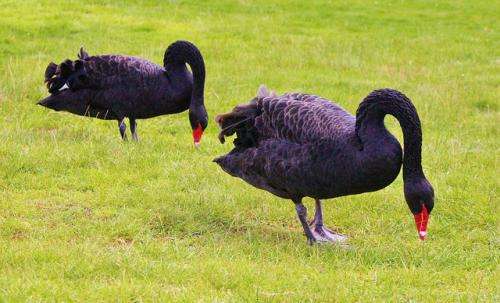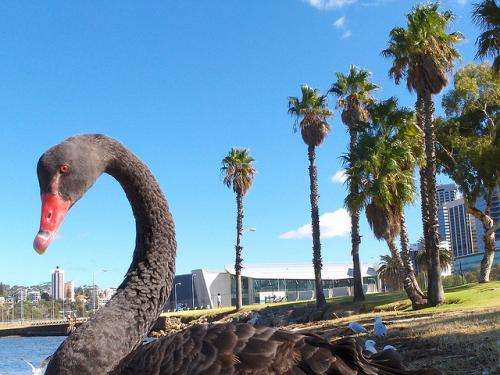"Swans rip out the whole seagrass when grazing—so you can see the clear, distinct mark which is sand where the swan fed," he says. Credit: louiscrusoe
Seagrass in the Swan River needs to be protected to help maintain populations of WA's iconic black swan.
Edith Cowan University researcher Gary Choney investigated the grazing pressure black swans (Cygnus atratus) exerted on seagrass in the lower Swan River, between the Narrows Bridge and East Fremantle, as part of his Masters research.
He says the state's early explorers documented large numbers of the birds in the 1700s and he's surprised that, as the state emblem, more research hasn't been done into them.
He estimates there are now just 185 birds in the lower estuary in autumn, when they are most abundant, dwindling to just 53 in spring.
The research shows intrusions to shorelines and habitats by factors like dogs and jetties help determine swan numbers, but the biggest driver is seagrass abundance.
He examined the swan's grazing patterns on three seagrass species, Ruppia meagcarpa, Halophila ovalis and Zostera muelleri, in areas where they are known to feed
"Swans rip out the whole seagrass when grazing—so you can see the clear, distinct mark which is sand where the swan fed," he says.
"We can then calculate how much seagrass was in the plot and how much was consumed by the swan."
The investigation found that when swan abundance peaks, seagrass production is also at its peak and grazing pressure is delicately balanced.
black swan on the Swan River foreshore next to the Perth Convention and Exhibition Centre. Credit: Alexander Fortin
"One of the most interesting things is that although we see significant change in swan numbers over a year and more grazing with an increase in swan numbers, there wasn't actually a change in the percentage of seagrass production consumed," he says.
"When bird numbers peak in summer and autumn it is also when seagrass production is at its peak, so even though the swans ate more, the seagrass was able to produce just as much."
However, he says the balance could be upset if swans were forced to the river from outlaying wetlands drying because of factors like climate change or groundwater extraction.
In addition, seagrass is susceptible to algal blooms caused by suburban water runoff containing contaminates like phosphates and detergents.
"At the moment the balance is fine," he says.
"However there have been studies done using simulated experiments to test the effect of algal blooms and they have shown significant impact on seagrass, lessening its production and it isn't able to recover."
Provided by Science Network WA
























